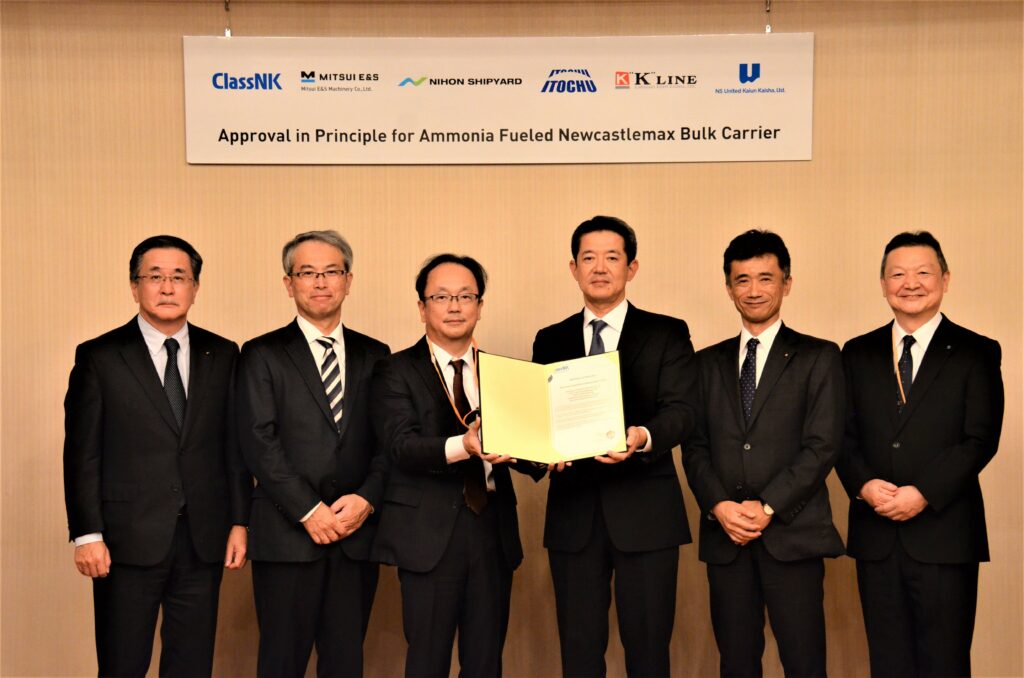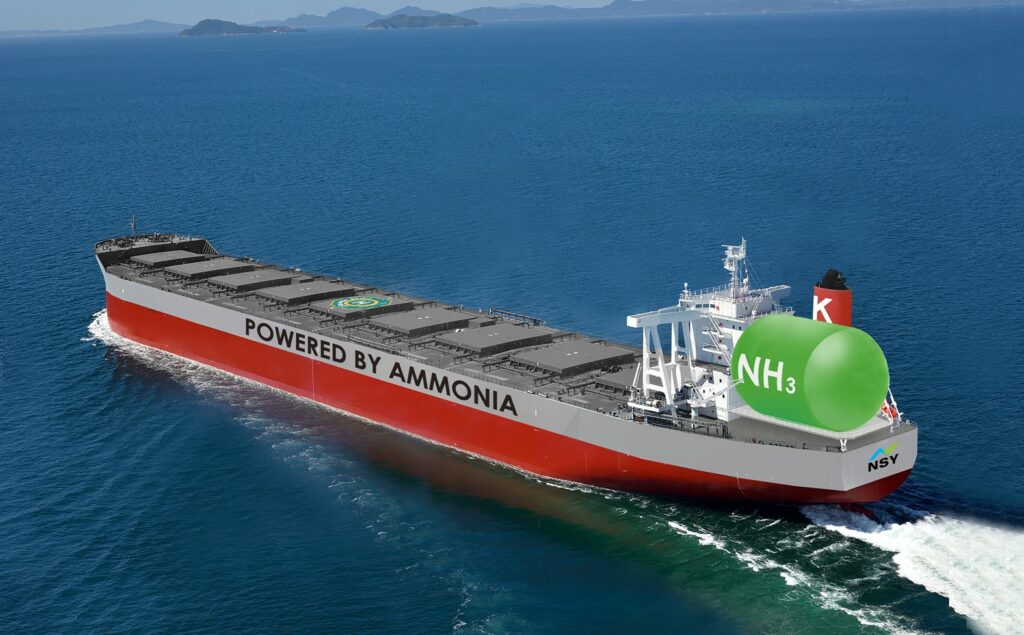Kawasaki Kisen Kaisha, Ltd. (“K” Line) announced today that, together with ITOCHU Corporation, Nihon Shipyard Co., Ltd., Mitsui E&S Machinery Co., Ltd., and NS United Kaiun Kaisha, Ltd., has obtained an Approval in Principle (AiP) from Classification Society, Nippon Kaiji Kyokai for the design of an ammonia-fuelled ship (200,000 deadweight ton class bulk carrier and hereinafter “the Vessel”).

Hiroyuki Tsubai, Senior Managing Executive Officer, ITOCHU Corporation;
Ichiro Tanaka, President & CEO, Mitsui E&S Machinery Co., Ltd.;
Hayato Suga, Executive Vice President, Nippon Kaiji Kyokai ;
Kiyoshi Higaki, Vice President, Nihon Shipyard Co., Ltd.,;
Masatoshi Taguchi, Managing Executive Officer, Kawasaki Kisen Kaisha, Ltd.;
Toru Fujita, Director, Managing Executive Officer, NS United Kaiun Kaisha, Ltd.
The vessel, which recently received an AiP, was developed by Nihon Shipyard as the part of the “Integrated Project for the Development and Social Implementation of Ammonia Fuelled Ships” which was jointly adopted by “the Green Innovation Fund Project / Development for Next-Generation Ships / Development of Ammonia Fuelled Ships” of the New Energy and Industrial Technology Development Organization (NEDO) (Note1).
At this time, there are no international guidelines for the use of ammonia as marine fuel, so ““K” Line and partners are looking toward obtaining Alternative Design Approval (Note 2) for the shipbuilding of the Vessel. A risk assessment (Hazard Identification Study – “HAZID”) was recently conducted on the safety of using ammonia as marine fuel, and the basic design of the Vessel was evaluated as “capable of ensuring the same level of safety as ships operating with existing fuel”.
The acquisition of the AiP is an important milestone for the implementation of ammonia-fuelled ships, a new challenge for the maritime industry, and also an important step toward the further promotion of the “Integrated Project” being facilitated by ITOCHU Corporation. “K” Line and partners will proceed with the development of the Vessel based on the basic design for which the AiP has been obtained, and aims to take delivery of the Vessel and begin its social implementation in 2026.

“K” Line has revised a part of its long-term environmental guideline, “K” Line Environmental Vision 2050 (Note3) in Nov 2021 and has set a new goal for 2050 “to achieve net zero GHG emissions”.
As a comprehensive logistics group based on the shipping industry, “K” Line Group will continue to work to reduce its environmental impact in order to realize a sustainable society and increase its corporate value, based on its corporate philosophy of “contributing to the enrichment of people’s lives”.
(Note1)Announced on 26th October 2021:
Joint project on “Development of Ammonia-fuelled ship” adopted as Green Innovation Fund
(Note2) Alternative Design Approval is to prove that the ship is as safe as a ship built in accordance with existing international regulations and to obtain approval from the competent authorities when the ship is designed without any international guidelines. Ships designed in accordance with ClassNK guidelines, such as the vessel, may use ammonia as a marine fuel if they are approved by the competent authorities in accordance with the SOLAS Convention (International Convention for the Safety of Life at Sea) and are built according to an approved alternative design.
(Note3) “K” LINE Environmental Vision 2050 can be seen in below link:
https://www.kline.co.jp/en/csr/environment/management.html#002






